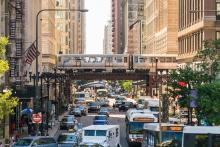A dozen City departments and agencies have been working for months with traffic safety stakeholders to develop the Vision Zero Action plan, which covers the first three years of the effort and is based on the principles of the international Vision Zero movement. It incorporates traffic crash data, identifies the greatest opportunities for change and establishes the City’s priorities and resources for addressing the challenge.
As part of the planning for Vision Zero Chicago, the City has used crash data to identify 43 high crash corridors and eight high crash areas. Of the high crash areas, seven of the eight are on the west and south side of the city, with the remainder being downtown where the higher crash rate is correlated with higher density and higher volumes of vehicles and pedestrians. In addition, the data shows that people who live in areas of high economic hardship are three times as likely to die as a result of a traffic crash.
Police efforts under Vision Zero will be focused on education and engagement events in high crash areas and corridors. While enforcement is an important and effective tool in preventing dangerous driving behaviours, Chicago Police Department will work in partnership with communities and residents to ensure that all traffic safety interventions are fair and focused appropriately.
Communities most heavily affected by severe traffic crashes will be prioritised for outreach and education, starting with a pilot project this summer on the West Side, funded by an US$185,000 grant from the
Under the three year plan, CDOT is committed to improving 300 intersections to make them safer for pedestrians. CDOT will also work with the
Vision Zero will also implement policies, training and technologies that create safer vehicles and safer professional drivers throughout the City, including with drivers in the City’s fleet of vehicles as well as taxi and transportation network provider drivers.
The City will lead by example through the installation of low-cost, life-saving equipment on large trucks in the City fleet, such as the installation of sideguards and convex mirrors on its large trucks. It will also propose an ordinance that will require City contractors to make these same safety improvements on their large trucks.
“Chicago has made progress in making our streets safer, but we still experience far too many traffic crashes. The status quo is unacceptable,” Mayor Emanuel said. “We will streamline our efforts to protect the lives, health and well-being of all Chicagoans.”
Chicago mayor unveils Vision Zero Action Plan
Chicago Mayor Emanuel has announced the city’s Vision Zero Chicago Action Plan, a multi-Agency approach which aims to improve traffic safety for all road users. The ultimate goal of Vision Zero is to reduce roadway crashes and eliminate traffic fatalities and serious injuries in Chicago by 2026. A dozen City departments and agencies have been working for months with traffic safety stakeholders to develop the Vision Zero Action plan, which covers the first three years of the effort and is based on the princi
Chicago Mayor Emanuel has announced the city’s Vision Zero Chicago Action Plan, a multi-Agency approach which aims to improve traffic safety for all road users. The ultimate goal of Vision Zero is to reduce roadway crashes and eliminate traffic fatalities and serious injuries in Chicago by 2026.









